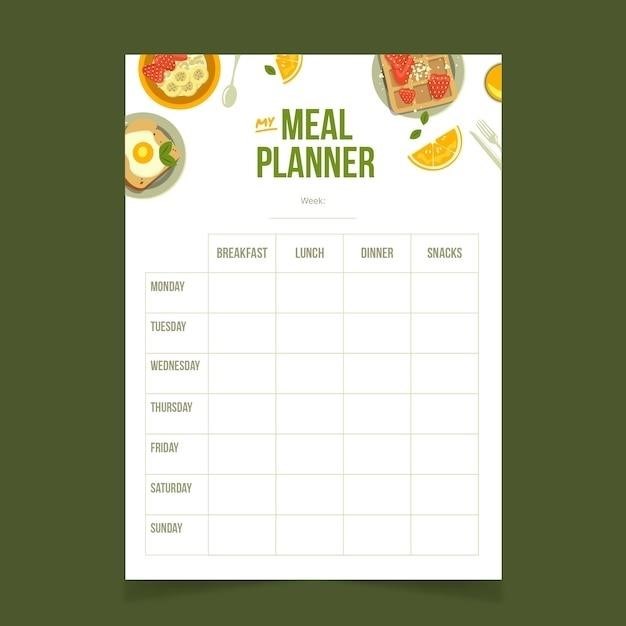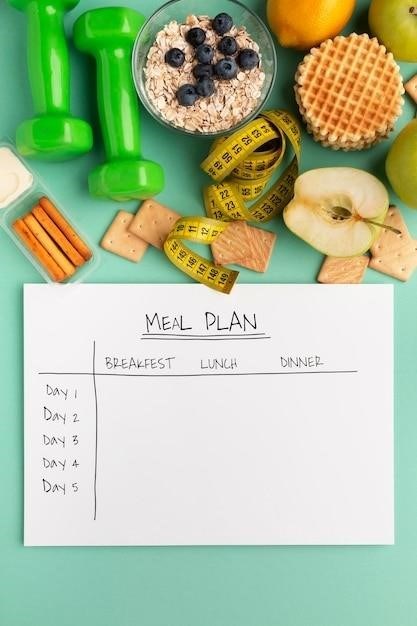
Carb Cycling Meal Plan⁚ A 12-Week Guide
Carb cycling is a popular diet strategy that involves alternating your carbohydrate intake on different days to optimize your metabolism and fat loss. This 12-week guide will help you create a personalized carb cycling meal plan that fits your needs and goals.
You can find a variety of resources online that offer sample meal plans and advice on carb cycling, including PDFs that provide a detailed breakdown of your daily intake for each day of the week.
By following a structured carb cycling approach, you can improve your energy levels, enhance your athletic performance, and potentially accelerate your fat loss journey. Remember to consult with a healthcare professional before making any significant dietary changes.
What is Carb Cycling?
Carb cycling, also known as carbohydrate cycling, is a nutritional strategy that involves strategically manipulating your carbohydrate intake on different days of the week. It’s not a rigid diet but rather a flexible approach to eating that aims to optimize your body’s response to carbohydrates for various goals, such as weight loss, muscle gain, or athletic performance enhancement.
The basic principle of carb cycling is to alternate between high-carb, moderate-carb, and low-carb days based on your activity levels and fitness objectives. High-carb days provide your body with ample energy for intense workouts and recovery, while low-carb days help promote fat loss and enhance insulin sensitivity.
Carb cycling is a personalized approach, meaning that the specific carb intake and meal plan can vary depending on individual factors like your metabolism, activity level, and dietary preferences. It’s crucial to consult with a registered dietitian or certified personal trainer to design a carb cycling plan that aligns with your unique needs and goals.
Benefits of Carb Cycling
Carb cycling offers a range of potential benefits, making it an appealing dietary strategy for individuals seeking to improve their health and fitness. Here are some of the key advantages⁚
Enhanced Weight Loss⁚ By manipulating carbohydrate intake, carb cycling can help regulate insulin levels, promoting fat burning and potentially aiding weight loss.
Improved Body Composition⁚ Carb cycling can contribute to a more favorable body composition by supporting muscle growth during high-carb days and promoting fat loss during low-carb days.
Increased Energy Levels⁚ High-carb days provide the body with ample glycogen stores, ensuring sufficient energy for intense workouts and physical activities.
Enhanced Athletic Performance⁚ Carb cycling can optimize energy availability for training and competition, potentially enhancing athletic performance and endurance.
Improved Insulin Sensitivity⁚ By reducing carbohydrate intake on certain days, carb cycling can help improve insulin sensitivity, leading to better blood sugar regulation and potentially reducing the risk of chronic diseases.
How to Create a Carb Cycling Meal Plan
Crafting a successful carb cycling meal plan requires careful consideration of your individual needs and goals. Follow these steps to create a plan that works for you⁚
Determine Your Daily Carb Needs⁚ Calculate your daily calorie requirements based on your activity level and weight goals. Then, determine your ideal daily carbohydrate intake by considering your macro goals and desired body composition.
Plan Your Weekly Activities⁚ Map out your weekly exercise schedule, including high-intensity training sessions, moderate workouts, and rest days. This will help you determine the appropriate carb intake for each day.
Adjust Your Daily Carb Intake Accordingly⁚ On high-intensity training days, consume higher carbohydrates to fuel your workouts. On rest days or low-intensity days, reduce your carb intake to promote fat burning.
Remember to prioritize whole, unprocessed foods, including lean protein, healthy fats, and fibrous vegetables. Consult a registered dietitian or nutritionist for personalized guidance and to ensure your plan meets your individual needs;
Step 1⁚ Determine Your Daily Carb Needs
Before you can start carb cycling, you need to understand how many carbs your body needs each day. This will vary depending on your activity level, weight goals, and overall calorie intake. A good starting point is to use a macro calculator to determine your daily macronutrient needs, including carbohydrates.
You can find various online calculators that will ask for your age, sex, height, weight, activity level, and goals to calculate your daily calorie and macronutrient requirements. Once you have this information, you can start to plan your carb cycling schedule.
Remember that these are just general guidelines. If you have any specific dietary concerns or health conditions, it’s always best to consult with a registered dietitian or nutritionist for personalized guidance. They can help you create a safe and effective carb cycling plan that aligns with your individual needs.
Step 2⁚ Plan Your Weekly Activities
Carb cycling is designed to work in tandem with your activity levels. You’ll want to schedule your high-carb days to coincide with your most intense workout days; This is because your body needs carbohydrates for fuel during exercise, particularly high-intensity workouts.
On low-carb days, you’ll be aiming to reduce your carbohydrate intake while maintaining adequate protein and healthy fats. These days are often scheduled on rest days or days with less intense physical activity.
For example, you might choose to have a high-carb day on Monday for a heavy leg day at the gym, followed by a low-carb day on Tuesday for a rest day or a light cardio session. By syncing your carb intake with your exercise routine, you can optimize your body’s energy use and potentially enhance your performance and recovery.
Step 3⁚ Adjust Your Daily Carb Intake Accordingly
Once you’ve determined your daily carb needs and planned your weekly activities, you can start adjusting your daily carb intake based on your chosen carb cycling schedule. This involves strategically dividing your carbohydrates across your low, medium, and high-carb days.
On high-carb days, you’ll consume a higher amount of carbohydrates to fuel your intense workouts and replenish your glycogen stores. This could range from 175 to 275 grams, depending on your individual needs.
On low-carb days, you’ll significantly reduce your carbohydrate intake, typically to 100-125 grams, allowing your body to utilize stored fat for energy. Medium-carb days fall somewhere in between, providing a moderate level of carbohydrates to support your overall energy needs.
Remember that these are just general guidelines, and you may need to adjust your carb intake based on your individual goals, activity levels, and how your body responds.
Sample 12-Week Carb Cycling Meal Plan
A sample 12-week carb cycling meal plan can provide a starting point for structuring your meals, but it’s important to adapt it to your individual preferences and needs. You can find numerous online resources offering such meal plans, often in PDF format, with detailed breakdowns for each day of the week.
These plans often include a mix of low, medium, and high-carb days, providing a variety of food options to keep your meals interesting; For example, a typical week might include a no-carb day, three low-carb days, and three high-carb days.
Remember that these are just examples, and you can customize your meal plan to fit your dietary restrictions, food preferences, and activity levels. You can also adjust the meal plan throughout the 12-week period to keep things fresh and prevent boredom.
The key is to find a plan that works for you and helps you achieve your desired results.

Tips for Success
Carb cycling can be an effective strategy for weight loss and improved athletic performance, but it requires consistency and careful planning. Here are some tips to help you succeed with your 12-week carb cycling meal plan⁚
Listen to your body⁚ Pay attention to how your body feels on different carb days. Adjust your intake if you experience excessive fatigue, sluggishness, or cravings.
Stay hydrated⁚ Drinking plenty of water is crucial for overall health and helps regulate your metabolism. It’s especially important during periods of carb restriction.
Be patient⁚ It takes time to see results from carb cycling. Don’t get discouraged if you don’t notice immediate changes. Stick to your plan, and you’ll likely see improvements over time.
Experiment with different food options⁚ Explore a variety of healthy foods on different carb days. This will help keep your meals interesting and prevent boredom.
Seek professional guidance⁚ If you have any underlying health conditions or are unsure about carb cycling, consult with a registered dietitian or healthcare professional for personalized advice.
Potential Risks and Considerations
While carb cycling can be a beneficial strategy for some individuals, it’s essential to be aware of potential risks and considerations before embarking on this diet plan.
Nutrient deficiencies⁚ Restricting carbohydrates can lead to deficiencies in essential nutrients like fiber, vitamins, and minerals. It’s crucial to ensure you’re consuming a balanced diet with plenty of fruits, vegetables, and whole grains.
Metabolic adaptation⁚ Your body may adapt to frequent carb cycling, making it less effective for weight loss over time. It’s important to adjust your plan periodically to prevent plateaus.
Hormonal imbalances⁚ Extreme fluctuations in carbohydrate intake can disrupt hormonal balance, particularly in women. This can lead to irregular periods, mood swings, and other hormonal issues.
Gastrointestinal distress⁚ Rapid changes in carbohydrate intake can cause digestive problems like bloating, gas, and constipation. It’s essential to listen to your body and adjust your plan accordingly.
Individual variations⁚ Carb cycling can affect individuals differently. What works for one person may not work for another. It’s crucial to find a plan that suits your unique needs and preferences.


